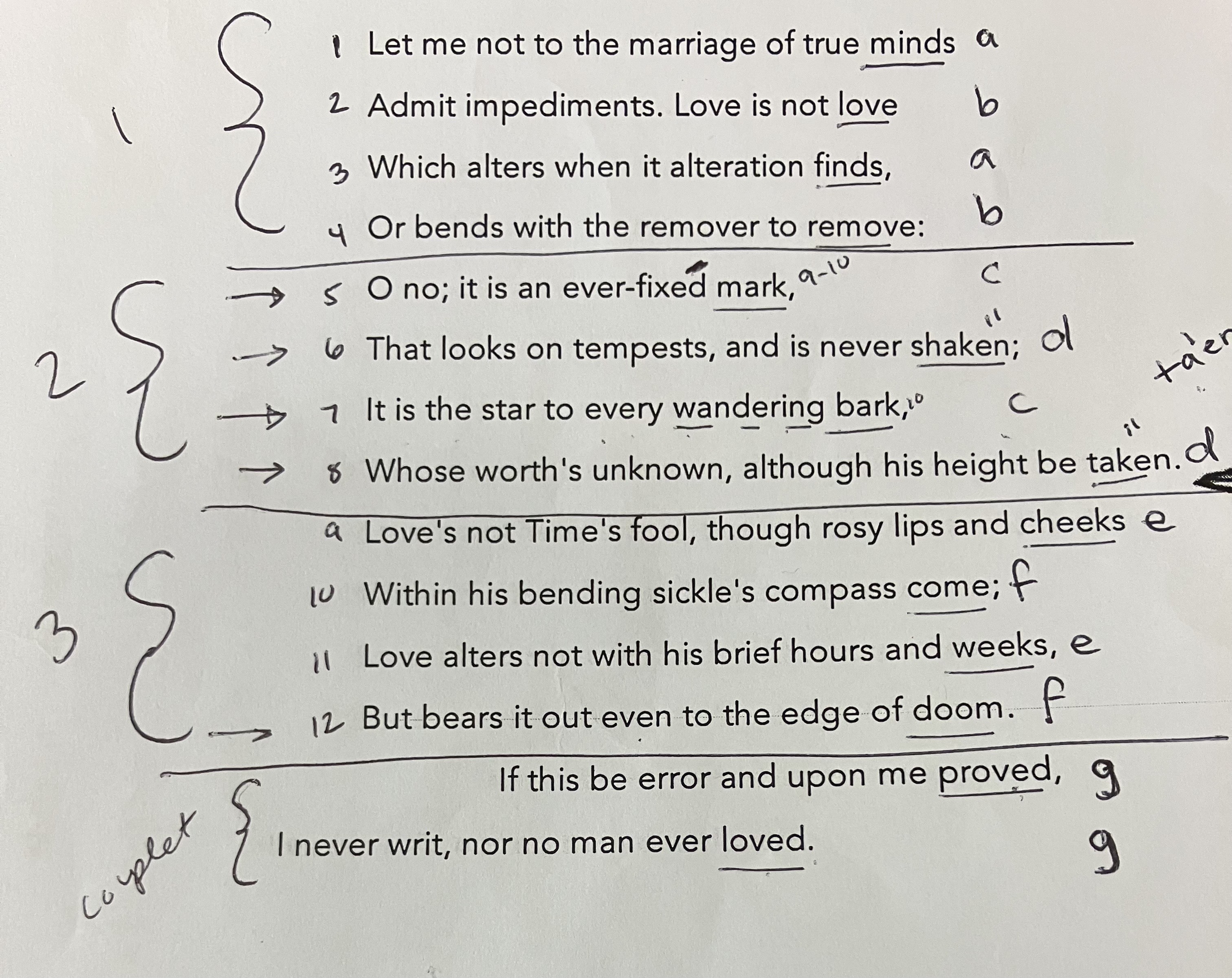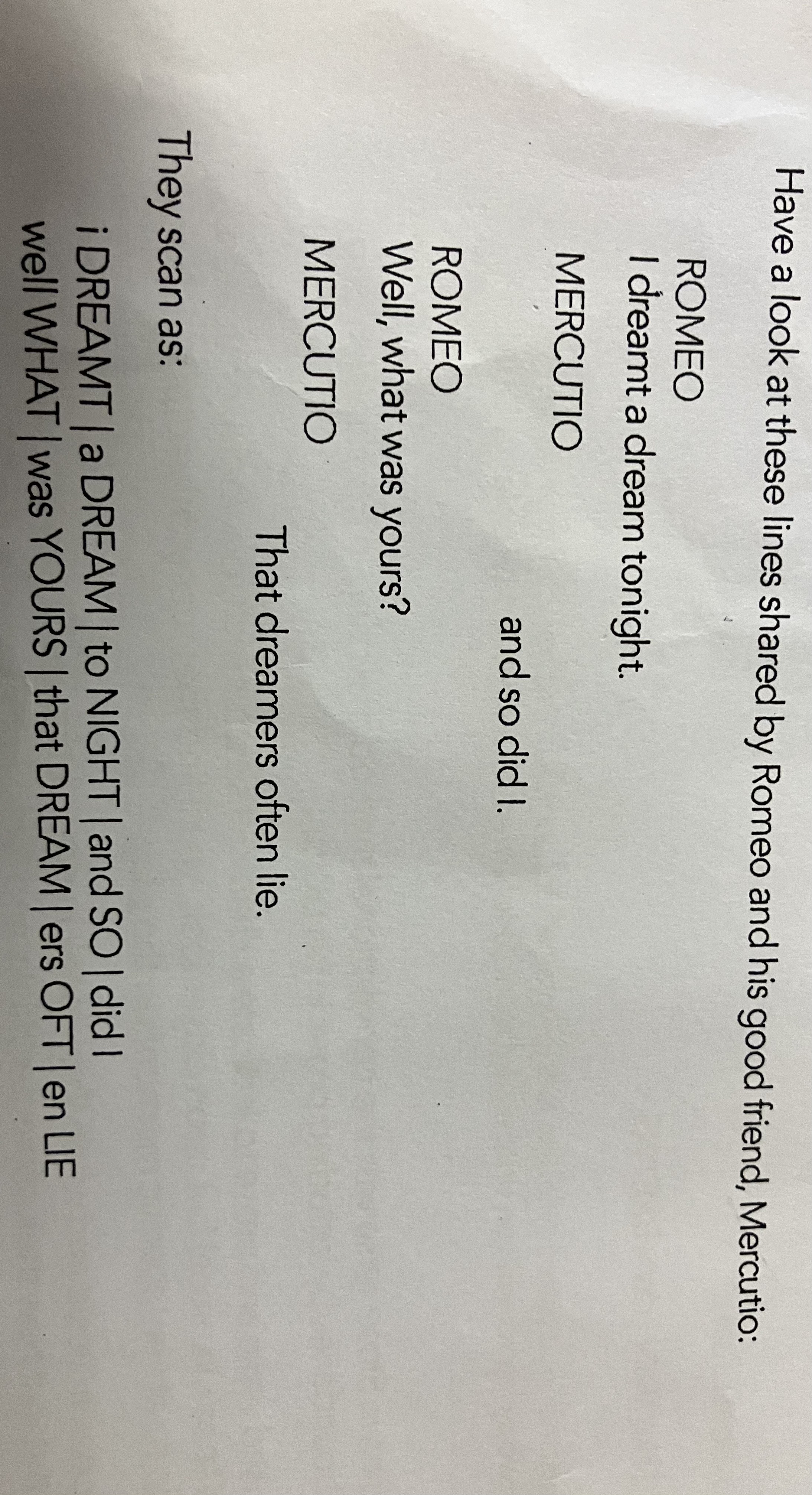Sonnets and Iambic Pentameter
1/13
Earn XP
Description and Tags
English Honors I
Name | Mastery | Learn | Test | Matching | Spaced |
|---|
No study sessions yet.
14 Terms
So what is a sonnet? How do you write one?
A sonnet is written in iambic pentameter. As you’ve already seen, an “iamb” is two syllables. The first syllable is unstressed, and the second syllable is stressed. When they are sounded together, you get a fall and a rise. Penta means five, so iambic pentameter is five iambs strung together.

So what is a sonnet? How do you write one?
A sonnet has fourteen lines. Most Shakespearean sonnets have a set rhyme scheme: abab cdcd efef gg.

A sonnet has _____ lines.
A sonnet has 14 lines.
A sonnet contains a couplet. A couplet is…
a pair of rhyming lines at the end of a sonnet (gg).
A sonnet contains _____ quatrains.
A sonnet contains 3 quatrains.
A quatrain is…
group of 4 lines grouped by rhyme scheme (abab).
Iambic Pentameter means each line of the poem has…
10 syllable (5 iambs).
What is the difference between verse or prose?
All of Shakespeare’s language falls into one of two categories: verse or prose. prose is what we think of as everyday speech, without specific rules regarding rhyme or rhythm. Verse, then, can be defined as giving order or form to the random stress patterns of prose. A quick way to tell verse from prose: lines of verse begin with capital letters, while prose will appear in paragraph form.
What is blank verse?
Blank Verse is the standard poetic form Shakespeare used in his plays. It can also be defined as unrhymed iambic pentameter — that is, a line of poetry containing five (“penta” from the Greek prefix meaning five) iambic feet, not rhyming with any adjacent line. That’s ten syllables altogether. The pattern flows easily for speakers of English, because the stresses match the human heart beat.

What is prose?
Prose is the everyday language used then and now. Since verse was the conventional method of writing in Elizabethan England, Shakespeare was actually pushing the literary boundaries by including prose in his plays.
At first glance, it may seem that Shakespeare used verse and prose to indicate a character’s status (rich, powerful, educated characters speak in verse; poor, common, fools speak in prose) but upon closer look, you’ll find that many characters go back and forth between verse and prose, and they do so at very specific moments in the play.
Actors pay close attention to when characters speak in verse and when they speak in prose because Shakespeare made these choices on purpose, and it can tell the actor a lot about how their character thinks and feels. For example, the Nurse is likely to speak in prose when she is teasing Juliet. But she switches to verse when the conversation becomes more serious.
What is a irregular verse?
Shakespeare doesn’t always write verse in perfect iambic pentameter. The rhythmic patterns change, and so do the number of syllables. This was pretty innovative stuff in Shakespeare’s day. He was one of the first writers to break form. Just like a change from prose to verse is a clue for the actor, so is a variation in the verse pattern.
What is feminine endings?
A “feminine endings” is a line of verse that ends with an unstressed extra syllable. The result is that the rhythm of the verse is thrown off just enough to indicated that the characters feel unsettled about something. Here’s an example, spoken by Juliet when she finds out that she must marry Paris.

What is shared lines and split lines?
Shakespeare sometimes splits a line of verse, so that two characters share the ten syllables. This is called a shared line or a split line, and it helps to show quick thinking or strong emotion, as well as creating a sense of accelerated action. Thus we have both the effect of poetry AND of a natural speech.

What is a rhyming couplet?
Four short, simplistic sentences becomes a rhyming couplet. A rhyming couplet is a pair of lines of the same length whose end words rhyme. Shakespeare often uses these to signal the end of a scene, or to foreshadow something yet to come.